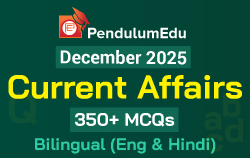Daily Current Affairs and GK | 01 April 2020

Happy New Year get 35% Off
Use Coupon code NY2026
1. Government cut interest rates on small savings schemes
- The government has cut interest rates on small savings schemes by 1.4%.
- The government has cut interest rates on small savings schemes, including the National Savings Certificate and the Public Provident Fund, for the first quarter of 2020-21, a cut consistent with the moderation in bank deposit rates.
- Interest rates on small savings schemes are notified on a quarterly basis.
- After this reduction, the interest rate will now come down to 5.5% from the current 6.9% on deposits of 1-3 years.
- While the interest rate on deposits of five-year duration will come down to 6.7% from the current 7.7%.
- National Savings Certificate, popularly known as NSC, is a savings bond of the Government of India, mainly used for small savings and income tax saving investments in India.
- Public Provident Fund was started in 1968 with the objective of raising small savings as an investment in India. There is a savings-cum-tax saving instrument in India.
2. Supreme Court upheld right to discuss COVID-19
- Recently the Supreme Court has given the authority to discuss COVID-19.
- A bench led by Chief Justice of India Sharad A. Bobde has given this decision in response to a request from the central government.
- The Supreme Court directed the media to publish the official version of the daily events to avoid rumor and widespread panic.
- Along with this, the government was also ordered to start a daily bulletin on the developments of Covid-19 through all media in the next 24 hours.
- It is known that creating panic is also a crime under the Disaster Management Act, 2005.
3. Ministry of Health allowed use of hydroxychloroquine combination
- Recently the Ministry of Health has approved the use of azithromycin with hydroxychloroquine for patients with COVID-19.
- But this requires special monitoring and ICU management, as per the latest guidelines on clinical management of COVID-19.
- Currently, this medicine is not recommended for children under 12, pregnant and lactating women.
- However, this decision is compatible with the current circumstances, which will be reviewed from time to time.
- Azithromycin is used to treat a wide variety of bacterial infections, such as respiratory infections, skin infections, ear infections, eye infections, and sexually transmitted diseases.
4. D. Lakshminarayanan made Managing Director of Sundaram Finance Limited
- Recently D. Lakshminarayanan has been promoted to the post of Managing Director of Sundaram Finance Limited.
- He has taken over the charge from April 1.
- Mr. Lakshminarayan has been with the Sundaram Finance Group for more than ten years.
- He will replace Srinivas Acharya, who retired on 31 March 2020.
- Mr. Acharya was part of Sundaram Finance Group for nearly 40 years and since 2010 held the post of MD of the company.
- Sundaram Finance Limited:
- Sundaram Finance Limited is a financial and investment services provider company in India. It is located in Chennai and has more than 640 branches across the country.
- It was established in 1954 by T.S. Santhanam.
5. Indian Institute of Technology, Bombay developed a portable ultraviolet sanitizer
- Recently, the Industrial Design Center (IDC) of the Indian Institute of Technology, Bombay has developed a portable ultraviolet sanitizer.
- This sanitizer cleans purses, wallets and other small items that passes from one hand to another.
- This UV sanitizer is made using stainless steel kitchen containers and aluminum lattice and is currently in the concept verification stage.
- This sanitizer design is based on a study published by the US National Library of Medicine in a journal called PubMed.
- The study demonstrates how ultraviolet C light neutralizes severe acute respiratory syndrome coronavirus, Crimean-Congo haemorrhagic fever virus, and Nipah virus.
- This sanitizing gel cannot be used on items such as paper, files, currency, notes and phones.
6. First reported case of acute encephalitis syndrome (AES) of 2020 in Bihar
- Recently, the first case of acute encephalitis syndrome (AES) has been reported in Bihar in 2020.
- AES is locally known as chamki bukhar and has killed more than 500 children in Bihar in the last decade.
- Muzaffarpur, Vaishali, Sitamarhi, Samastipur, Shehar and East and West Champaran were the most affected areas in Bihar.
- Acute encephalitis syndrome (AES):
- It is a serious public health problem in India.
- Fever, convulsions and mental confusion are its main symptoms.
- The disease affects children and young adults the most.
- AES is mainly caused by viruses, although bacteria, fungi, parasites, spirochetes, chemicals, toxins and non-infectious agents may also be responsible factors.
- Japanese Encephalitis virus has been the major cause of AES in India.
7. Central Government has increased the validity of health organizations listed under CGHS
- Recently, the Central Government has increased the legitimacy of health organizations listed under the Central Government Health Scheme (CGHS).
- This list will be considered valid till June 30 this year or till the next date of listing, whichever is earlier.
- In this case, the terms and rates will be the same as before.
- All hospitals and diagnostic centers will provide services at the board's rates, for screening tests recognized by the NABL.
- Non-NABL rates may be charged for any other investigation.
- The Central Government Health Scheme provides comprehensive health care facilities for central government employees. It was started in 1954 in New Delhi.
- National Accreditation Board for Testing and Calibration Laboratories (NABL):
- It is an autonomous body under the aegis of the Department of Science and Technology.
- Its objective is to accredit testing of clinical laboratories in the country.
- It was founded in 1988.
- Its headquarters is located in Gurugram, Haryana.
Topic of the Day - "Peninsular Rivers"
The peninsular river system is much older than the Himalayan river system. This is evident from the maturation of broad, largely graded shallow valleys and rivers.
The characteristics of peninsular rivers are as follows:
- These rivers are rainfed, seasonal in nature and not perennial. During summer, the amount of water in them decreases significantly.
- The wide and shallow valleys characterize these rivers.
- They flow through hard rock. Their erosion action is very less; therefore, they lack silt and sand.
- Due to low gradient, the water velocity and load carrying capacity in these rivers are low.
- Most of the major rivers of the peninsula such as Mahanadi, Godavari, Krishna and Cauvery flow eastward and fall into the Bay of Bengal, while Narmada and Tapi are the only two rivers that flow westward and fall into the Arabian Sea.
1. Narmada - It is also called the lifeline of Madhya Pradesh and Gujarat. It flows through the Rift Valley.
Source- Amarkantak Mountains, Madhya Pradesh
Immersion - Arabian Sea
Tributaries- Sher, Shakar, Dudhi, Tawa, Ganjal, Deer, Barna, Choral, Karam and Lohar are important tributaries.
2. Tapi - Tapi River also flows through the Rift Valley from the states of Maharashtra, Gujarat and Madhya Pradesh.
Source - Satpura Range, Madhya Pradesh
Immersion - Arabian Sea
Tributaries- Poorna, Girna and Panjhra are the three major tributaries.
3. Mahanadi- Mahanadi is also known for the Hirakud Dam. This river flows through the states of Chhattisgarh and Odisha.
Source - Sihawa Mountains in Chhattisgarh
Immersion - Bay of Bengal
Tributaries- The major tributaries of Mahanadi are Sontha, Jonk, Hasdo, Mand, Ib, Ong, Tel etc.
4. Godavari - Godavari is the second longest river in India after the Ganges. It is also known as the Ganges of the South.
Source- Trimbakeshwar Mountains of Maharashtra
Immersion - Bay of Bengal
b - Poorna, Pranahita, Indravati, Pravar, Manjira, Maniyar and Sabari are the major tributaries of the river.
5. Krishna - Krishna River Ganges is the fourth largest river in India in terms of water flow and river basin area.
Source - Mahabaleshwar, Maharashtra
Immersion - Bay of Bengal
Tributaries - Venna, Koyna, Panchganga, Doodhganga, Ghatprabha, Malaprabha and Tungabhadra are the main tributaries of Krishna.
6. Cauvery - Cauvery is an Indian river which flows through the states of Karnataka and Tamil Nadu. It is the third largest river in South India after Godavari and Krishna. There is a dispute in the states of Tamil Nadu and Karnataka regarding its water sharing.
Source- Brahmagiri Hills, Karnataka
Immersion - Bay of Bengal
Tributaries - Harangi, Hemvati, Shimash, Arkavati are its major tributaries.
Multiple Choice Questions (MCQs)
1. Recently the government has cut interest rates on small savings schemes by what percentage?
A. 2
B. 3
C. 1.4
D. 1.5
2. Recently the Supreme Court bench has given the right to discuss COVID-19, who headed this bench?
A. S. A. Bobde
B. Madan Bhimrao Lokur
C. A. S. Bopanna
D. K. G. Balakrishnan
3. Azithromycin is used in which type of infection?
A. Respiratory infection
B. Sexually transmitted infection
C. Eye infections
D. All of the above
4. Who has been appointed as the Managing Director of Sundaram Finance Limited?
A. D. Lakshminarayanan
B. B. Sundaram
C. S. Kalyanam
D. Sukumar Swamy
5. Recently which Indian Institute of Technology has created a portable ultraviolet sanitizer?
A. Indian Institute of Technology, Delhi
B. Indian Institute of Technology, Guwahati
C. Indian Institute of Technology, Bombay
D. Indian Institute of Technology, Indore
6. What is not true in relation to acute encephalitis syndrome?
A. It is a serious public health problem in India.
B. Fever and mental confusion are its main symptoms.
C. This disease affects children and young adults the most.
D. AES is caused only by the virus.
7. Where is the headquarters of the National Accreditation Board for Testing and Calibration Laboratories located?
A. Haryana
B. Karnataka
C. Uttar Pradesh
D. New Delhi
Solution:
1. C
2. A
3. D
4. A
5. C
6. D
7. A





 31 March 2020 Current Affairs
31 March 2020 Current Affairs 








Comments